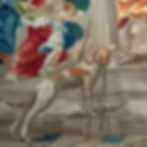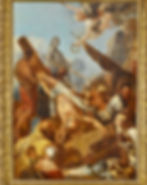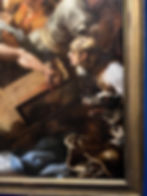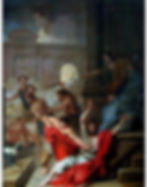Tapestry Travel: Dogs from the Exhibition Les Grands Décors de Notre-Dame (Great Restored Decors of Notre-Dame)
- Camilyn Leone
- Sep 2
- 7 min read

What do you take away from a once in a lifetime exhibit of massive, magnificent tapestries and paintings restored after Notre-Dame burned in 2019?
Dogs.
I took away memories of these artistic master pieces thanks to man and woman’s best friend.
The exhibition Les Grands Décors de Notre-Dame was held at the Galerie des Gobelins in Paris from April 24 to July 21, 2024. As a budding tapestry weaver and Francophile, I made reservations to go to Paris in time to see this exhibition for the tapestries. I had not been to Paris since 1990. I had just retired from my attorney career. Both kids had started college, and my husband wasn’t that thrilled about going to Paris right before the Olympics. Given this convergence of conditions, the stars aligned for me to spend 9 days, alone, in Paris.
As part of the preparation for the opening of Notre-Dame after the fire in 2019, Gobelins and the Centre de Recherche et de Restauration des Musées de France restored 14 tapestries, the Mays (series of paintings given every year in May to Notre-Dame), and several other artifacts. The exhibition was held at the gallery space at Manufacture des Gobelins. Gobelins is a tapestry factory located in the 13th arrondissement in Paris. It was founded in 1602 and is best known as Louis XIV’s factory for all things beautiful for his palace, Versailles. There are three tapestry studios that still produce tapestries and rugs for public and private concerns. You can visit these studios and see the master artists and weavers creating new tapestries.
I went to see Les Grand Décor de Notre-Dame twice. The first time, I was a bit jet lagged and just happy that I successfully navigated my way to Gobelins. I was scheduled for a tour but goofed on the time. So, I just wandered around and looked at all the paintings. After several minutes, a tour began with a French speaking guide. I loitered around the tour group and listened. The guide explained the significance of the Mays and the restoration process. He spent a lot of time on each of the paintings which reference classical and biblical stories. Each painting has symbolism associating France with the Roman Empire and, of course, God’s will that the French monarch rules the people. I appreciate painting, but I wanted to get to the tapestries.
The tour moved up stairs, where 7 of the 14 tapestries were on display. The tapestries are so enormous that only 7 could be displayed at a time for one week. I wish that I could have stayed two weeks in Paris and seen them all. Commissioned by Cardinal Richelieu, these fourteen works depicting the life of the Virgin, were originally intended the choir of Notre-Dame de Paris. The tapestries have a long and complicated political history. Though they were created for Notre-Dame around 1730, they were sold to the Cathedral Chapter of Strasbourg, France in 1739. Louis XIV sold them because he wanted new décor for Notre-Dame. At the time that they were sold, Strasbourg had only been part of France for about 50 years. Thus, buying the tapestries from Louis XIV was a smart political move, showing loyalty to the French monarch and an affirmation of Strasbourg’s cultural sophistication. Tapestries were like Beyoncé or Lady Gaga. People wanted to see them.
Back to the tour, the curatorial descriptions for tapestries were excellent and reading the cards proved to be more informative than listening to the guide. I studied the cards and looked at the tapestries. I was tired and hungry. I left without feeling like I was appreciating the tapestry before me. I promised myself to return for my scheduled tour with hopes that it would be more informative.
Visit two was much better. My tour guide spent most of the tour on the paintings and only a few minutes with the tapestries. But I was rested and fed and able to take in more posted curatorial information about the exhibit. I studied the compositions, based on cartoons created by Jacques Stella (1595-1657) and Charles Poerson (1609-1667), noted artists of their time. During the 17th century, tapestries were designed to emulate paintings by great artists. The point of tapestry weaving during this period was to recreate master paintings. The cartoons were financial and cultural currency. Famous painters of that era created cartoons for tapestries. Tapestries could be reproduced, thus any patron with the money could have a tapestry masterpiece. The studio who owned the cartoons could keep selling tapestries if the artist or subject matter was in demand. The painters and weavers sought to create an experience of becoming part of the scene. Most of the weaving is attributed to Pierre Damour. Damour adapts weaving to mimic classical painting techniques such as linear perspective, chiaroscuro, realism and proportion to create the dynamic, narrative compositions.
I’m ambivalent about this period of tapestry history. To my eye, the use of painting principles looks forced woven grid. I much prefer the medieval period tapestries created prior to the Renaissance for their innovative use of the grid structure to create narrative compositions. But Cardinal Richelieu who commissioned the tapestries and Louis XIV liked the Renaissance painting aesthetics, so back to the show.
Given all this history, a limited knowledge of tapestry and human sensorial limits, how does one connect and appreciate a tapestry masterpiece? Find something that holds your attention and look for it as you go through an exhibition. For me, it’s dogs. The paintings and the tapestries are highly symbolic and so are dogs. Throughout art history, dogs are used to tell the viewer how to feel or who the good guy or the bad guy is in an artwork. Once I focused on the dogs, I felt that I good grasp the essence of each tapestry and take away a memory of its magnificence.
For example, in the Presentation of the Jesus in the Temple, we see the Virgin Mary presenting the baby Jesus to the Temple leadership. There are lots of people in awe and kneeling to the future king of the Jews. And, just in case you miss this symbolism, there is a loyal pointer looking up at its master. The red and white pointer looks as if he is so happy to know his master. He leans forward toward the baby Jesus with ears perked up and smiling. Alert, attentive and waiting to do his master’s bidding, the dog tells us how we should respond and feel in this historical moment.

In the Marriage at Cana, Jesus, his mother and his disciples are invited to a wedding at Cana in Galilee. When his mother notices that the wine has run out, Jesus delivers a sign of his divinity by turning water into wine at her request. The dog, also a pointer, is gleefully chewing on a bone. He lies at the foot of a guest who miraculously dropped a chop under the table. From the dog’s perspective, it’s a miracle! This is how the viewer is supposed to feel after Jesus changes water to wine. The dogs convey loyalty, gratitude and service, just as good Christians do.

Conversely, the dogs in the paintings tell a different story. In The Crucifixion of Saint Peter by Sébastien Bourdon (1643), a dog which appears to be a breed used for hunting bears, is snarling and ready to lunge at Saint Peter’s executioners. The vicious stance of the dog directs the viewer’s shock toward the Roman legion in the distance. The dog’s gaze is also upward, toward an angel descending to take St. Peter to heaven. With the dog, the artist helps the viewer foresee the decline of the Roman Empire and the rise of Christianity. In The Flagellation of Saints Paul and Silas by Louis Testelin (1655), we see a dog trying to protect his masters. The dog’s aggressive stance is directed toward the Roman magistrate. His mouth is open as if to bark as the magistrate strikes the Saints with reeds. His gaze is to the sky where we see thunderous dark clouds descend upon the Roman square. God is sending an earthquake to shake things up and the dog knows it.




These are just a few examples of my way of experiencing tapestry through a canine lens. Apart of the stories that the dogs help tell, I can see the artists’ and weavers’ skill. I can see the principles of design in a faithful interpretation of a loyal pet or vicious cur. Dogs spark my memory of the tapestries and of the history.
While I was in Paris, I visited several other museums to see tapestry. I looked for dogs. When I find a dog, I make a connection through time with the meaning of the tapestry. It’s a seemingly simple but profound method for appreciating art. Man’s best friend is full of surprises. I encourage you to look for dogs the next time that you go to a museum. As the saying goes, even an old dog can learn new tricks!
Tapestry Travel Information:
Tours of Gobelins are fascinating. Gobelins is like a 17th century village in Paris, a real step back in time. You can go into the studios and see the weavers and looms.
You can visit Notre-Dame de Paris and see the installed paintings called the Mays of Notre Dame now. Entry into Notre Dame is free. It’s best to go early in the morning. You can also buy reserved tickets from third party vendors if you are on a tight schedule. The inside of the church has been completely restored. There are also several modern tapestries hung in the chapels.
You can also see tapestry at the Cluny Museum, Museum of the Middle Ages. Here you will find the extraordinary Lady and the Unicorn Tapestries. There are several cute dogs in the series.
To see the Life of the Virgin tapestries, you have to go to Strasbourg Cathedral during Advent. I would love to go to Strasbourg at Christmas time and see the tapestries hung in the cathedral!
PS: If there aren’t dogs in the tapestry, I look for other animals. If there are no animals, then I look for feet. If there are no feet, then I look at clothing. And on and on . . . till I find an element that resonates with me.
